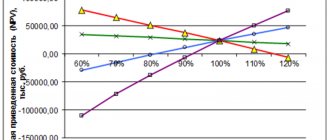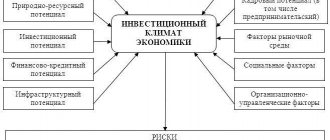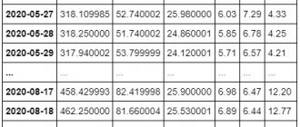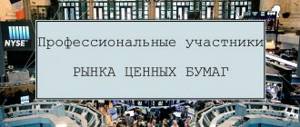The investment process is a sequence of stages and actions aimed at carrying out investment activities.
In each specific case, the essence and course of the investment process depend on the investment object under consideration. Thus, the investor’s actions will be different for financial and real investments.
The investment process is inextricably linked with investing money in order to make a profit. Thus, all investor activities should be aimed at purchasing assets that will create new value.
Life cycle of an investment project - what is it?
Each investment program has a life cycle (investment cycle), that is, the period of time from the beginning of the idea to invest money until the liquidation of the investment program. It is divided into four phases, which follow one after another. The phases differ in goals, objectives, and duration.
Thus, it is customary to distinguish the following phases:
- Pre-investment (includes research and analysis);
- Investment (design with subsequent conclusion of contracts);
- Operational or production (economic activities);
- Liquidation.
How to determine the completion date of a project?
At first it seems that everything is extremely clear; the life cycle begins from the moment when funds are invested and ends at the time when assets are withdrawn from the project.
But there are several subtleties here. Firstly, the cycle includes several stages: pre-investment, investment, production, liquidation. Secondly, some projects do not have a clearly defined end point. For example, you are purchasing an apartment for further rental and do not plan to sell it. Or another example, you buy shares for long-term ownership, wanting to earn money on dividends.
What to do when the end of the project cannot be determined with certainty?
The fact is that if you do not conditionally limit the project in time, then it will not be possible to analyze its effectiveness. After all, in investment analysis the value of the calculation horizon is used.
To solve this problem, it is necessary to conditionally determine the end of the project (for evaluation purposes). This can be done in several ways, taking the project life cycle to be:
- duration of creation and operation of the facility . In this case, the project implementation time is clearly defined;
- standard service life of the main (most expensive) equipment . Why is the horizon sometimes determined by the service life of road equipment? The fact is that after it ends, you will most likely have to update it. And since this is an expensive property, the renovation costs will be significant. Consequently, it will again be necessary to evaluate the effectiveness of investments.
- achieving the specified profit characteristics. In this case, the desired amount of profit from the investment is set. For example, an investor wants to know how long it will take to earn 1 million rubles;
- requirements of the investor , who may be interested in how much, for example, an investment project will bring him in 3 years or when he will fully return his invested investment resources.
The first phase of the investment project is pre-investment
Despite the fact that the first phase essentially stands behind the cycle of direct investment, it is the main one because at this stage a decision is made about where it is better and more profitable to invest money. In this case, the initiator of the future project will have to choose one of the ideas.
The selection criteria are:
- efficiency;
- riskiness;
- payback;
- viability (financial, technical, economic, organizational)
The investor may not participate at this stage, because often he is found during the first phase of the project.
At each stage of the pre-investment phase of the project, it is necessary to try to take into account the risks in order to prevent possible troubles.
The phase is identification, that is, at this moment it is determined why it was decided to create an investment project. The reasons may be: the presence of investors or their own free funds, as well as the desire to realize themselves in the type of business they are interested in. For convenience, a declaration of intent is drawn up.
This document contains information about:
- territorial location of the object;
- investor;
- environmental cleanliness of the facility (about the impact on the environment);
- sources of financing;
- proposed distribution channels for finished products;
- quantity and quality of necessary raw materials, labor, energy, and land resources.
Analysis
For a full analysis of the future program:
- determine the location of the investment object;
- determine the composition of available resources for program implementation;
- develop technical documentation;
- consider investment opportunities;
- develop a business plan;
- begin the search for a solvent investor;
- formulate the feasibility of investment measures.
Rationale
The written justification for the investment must take into account applicable local laws. It also contains a description of the goals of the entire project, characteristics of the objects that will be involved in the process of implementing the invested funds, and an analysis of the market in which the created organization is going to occupy a niche. A correctly compiled justification undergoes an examination. Based on the document, if necessary, a land plot selection certificate is issued.
At the end of the pre-investment stage, the prepared documents are agreed upon with the investor and the viability of the program is assessed, that is, the ability to generate cash flows.
Decision-making
At the third stage of the pre-investment phase, the final decision is made and one of the options is selected, if there are several of them. At the same time, an examination is carried out, the purpose of which is to prevent the functioning of objects that contradict the rights of legal entities and individuals, the goals and interests of the state. In particular, the project must comply with environmental, sanitary, economic, and social standards.
Development of feasibility study
At the last stage of the first investment phase, a feasibility study of the project is drawn up, which is a package of documents that includes:
- Constructive decisions;
- calculation and estimate documents;
- evaluation decisions;
- environmental justifications.
A feasibility study is required only if there are investments (including partial) from the state budget. The development of justification is carried out only by qualified specialists who have the appropriate license.
The feasibility study has approximately the following structure:
- The idea of the program.
- Description of marketing strategy and market analysis.
- Availability and description of resources.
- The location of the future facility and the environment that will influence its activities.
- Design and applied technologies.
- Structure of the organization and management body of the enterprise.
- Labor resources.
- Financial analysis and assessment of the return on future investments.
- Conclusions.
What it is
There are many definitions of the investment process. I won’t compare everything and choose the most accurate one.
The investment process includes the placement of finances in profitable assets - securities, shares in companies, commodities, etc. As a sequence, it has its own structure and is divided into stages.
In addition, this process implies:
- Participants involved in investment activities.
- Regulated relations between participants in the process.
- Circumstances that contribute to the success of an investment or, conversely, make the investment unsuccessful, resulting in losses for the person who invested the funds.
- Evaluating the effectiveness of the expected result.
The main circumstances influencing the very possibility of the process and its course:
- funds and their volume;
- objects of capital investment;
- ways to attract legal and/or individuals who have the necessary financial resources and are ready to place them in the business;
- investment climate;
- technical, organizational, legal support for the actions of all participants.
Participants in investment activities are otherwise called parties to contractual relations related to the placement of capital.
Investment phase
Investment or project implementation occurs in the second phase of the investment cycle.
It is at this time that certain actions are taken on specific investments, for example:
- development of investment project documentation;
- ordering, checking and installing equipment;
- construction of facilities;
- preparation of production sites;
- commissioning, survey, construction and installation works;
- modernization, reconstruction of existing production;
- conclusion of a contract;
- personnel training;
- development and implementation of promotional activities.
To implement the required investment plan, financial investments are required, so you cannot do without an investor at this stage. If the investment project includes the opening and operation of an enterprise, during this phase the permanent assets of this company are formed.
Participants in the process
These are organizations (enterprises) and individuals speaking:
- investors – the party investing funds;
- intermediaries;
- objects of investment.
There may be no intermediaries, since there are types of investment where capital holders invest directly in objects.
Example: In a stock exchange, investors are traders who invest money in buying securities; objects - companies whose securities are purchased by players, intermediaries - the exchanges themselves as trading platforms, as well as brokers conducting purchase and sale transactions on behalf of traders.
Besides a brokerage house, a prime example of an intermediary is a mutual fund. Here the investors become the shareholders, and the objects are the assets in which the mutual fund management company places investments. The investment fund accumulates shareholders' money, which is then invested in sources of profit.
Banks can also be called participants in the investment process, if transactions with investor funds take place through them, and insurance companies that insure capital investments.
Operational phase
At the third stage, the enterprise is launched, which was put into operation at the end of the previous phase.
Most of the implementation period of the entire project falls on this stage. In order for this period to be most effective, and the entire campaign to be crowned with success, it is necessary to extend the operational stage for as long as possible.
The operational phase includes:
- obtaining certificates for product release (if necessary);
- Production Management;
- promotion of the manufactured product on the market;
- monitoring product quality;
- organization of service;
- determining the point of reduction in consumer interest in the product.
Liquidation stage
The onset of the liquidation stage can be due to several different reasons. Firstly, it can start after all possibilities for further development of the investment project have been exhausted. Secondly, it can be triggered by a profitable commercial offer received by the asset owner from a third-party investor. Thirdly, investment can be curtailed in the situation described above, in which the existing project does not live up to expectations.
The liquidation stage for an investor is always additionally associated with the analysis of information obtained during the implementation of the project. The result of this should be specific conclusions about the mistakes and inaccuracies made that did not allow the maximum profit to be extracted from the asset. Such analytical work is carried out so that in the future the investor will more successfully implement future investment projects.
The final stage of the investment project is liquidation
After the depletion of resources or a decline in demand for a product, that is, at the time the set investment goals are fulfilled, the project is closed, that is, its liquidation phase.
In this case, the cost of fixed assets for their sale is determined, taking into account depreciation. If it is impossible to sell the machines, the equipment and other fixed assets are mothballed.
The liquidation phase does not always occur after goals have been achieved. There are situations in which it is necessary to prematurely end an unsuccessful project. The reason may also be a lack of funds from the investor, the discovery of errors in calculations, or the emergence of another project suitable for investment.
Article read: 654
What is the structure of the investment process
Effective investing necessarily includes:
- Collection of data about the market or its segment where the investment object is or will be conducting business activities.
- Development, implementation and adjustment of the investor’s strategy.
- An assessment of the amount of funds required to achieve success at the final stage (receiving maximum dividends).
- Selection of effective investment projects, planning their implementation.
- Assessment of the implementation of the investment stage.
If we talk about the investment process by a participant trading on the stock exchange, the structure includes:
- market analysis;
- choice of strategy;
- formation of a securities portfolio;
- operations with securities, when the share of profitable assets grows and unprofitable ones are discarded, as well as speculation in stocks, an increase in the volume of assets;
- performance assessment.
Basic indicators
You can draw a conclusion about how effectively investment processes are going at an enterprise or an individual investor based on an analysis of the following group of indicators:
- capital investment growth rate
- capital investment realization ratio
- the amount of investment per one ruble of expenses
- investment ratio
- coefficient of reproduction of fixed capital.
The essence of the investment process lies in the gradual introduction of the investor to the object of his investment, as well as in achieving the final result.
In order for the implemented processes of investment activity to be effective, their organization must be carried out based on the following principles:
- set the maximum amount of investment at which further investment is inappropriate
- principle of consistency
- accounting for additional expenses as the enterprise modernizes in the process of investment activities
- multiplier principle
- maintaining a balance between sufficient profitability and an acceptable level of investment risk.
When implementing investment processes it is possible:
- changing the form of invested funds from assets to investment expenses
- increasing the amount of invested funds by generating profit or the necessary economic effect.











